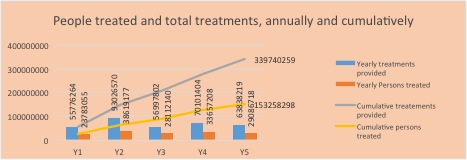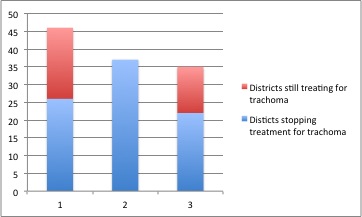END in Africa’s Five-Year Report Card
March 2nd, 2016
If projects were graded by the number of people they’ve help, the END in Africa project would have earned some pretty good grades for its first five years of operations. By the end of September 2015, the project had treated more than 153 million people[1] for at least one neglected tropical disease (NTD), giving out a total of almost 340 million treatments.[2],[3] These treatments help END in Africa beneficiary countries improve the health of their citizens as they work toward eliminating and controlling five NTDs—trachoma, lymphatic filariasis (LF), onchocerciasis (oncho), schistosomiasis (SCH) and soil-transmitted helminthiasis (STH).

Total number of people treated and treatments provided under the END in Africa project from October 2010 – September 2015, by year and cumulatively
Tremendous progress has already come out of all these treatments, and countries have made great strides toward eliminating trachoma and LF, in particular. Almost 70% of the districts (82 out of 118 districts) where trachoma had previously been found in Burkina Faso, Niger, Ghana, Sierra Leone and Togo (the five original END in Africa countries), now see so few new cases that they’ve been able to stop treating residents for that disease. Ghana has been able to stop treatment for trachoma nation-wide, becoming the first END in Africa country to do so.

Number of districts that have stopped LF treatments in END in Africa countries, as of September 2015
Likewise almost 60% of the districts (131 out of 221) where LF had been found in the original five END in Africa countries, have been able to stop LF treatments, as new cases of LF are now almost unheard of there. Togo has even been able to stop treating residents for LF nation-wide, since the entire country is now free from new cases of LF.
By adopting integrated treatments, the countries supported by END in Africa have also improved their process for treating residents for NTDs. Previously, countries treated people separately for each NTD. However, END in Africa support has helped enable them to treat residents for several diseases at once, improving efficiencies and reducing time and resource costs for citizens and national NTD programs, alike.

Number of districts that have stopped trachoma treatments in END in Africa countries, as of September 2015
Burkina Faso, Ghana, Sierra Leone and Niger now combine treatments LF and oncho. They also deliver treatments for SCH along with those for STH. Trachoma treatments are still conducted separately, however, so as not to overburden community distributors, most of whom are volunteers. Togo, which currently treats citizens for just three NTDs—oncho, STH and SCH—has taken integration a step further, treating residents for all three NTDS in a single visit.
Although such progress is wonderful news, the ultimate goal of disease elimination and control has yet to be achieved in the countries that END in Africa supports. In 2015, the United States Agency for International Development (USAID) decided to extend the END in Africa project, administered by FHI 360, for an additional three years (through September 2018) in order to continue advancing toward this goal. It also added a new country—Ivory Coast—to the END in Africa portfolio in October 2015.

People treated and total NTD treatments by country under the END in Africa project, Oct 2010 – Sept 2015
It’s important to acknowledge the challenges that END in Africa and the countries have faced over the past few years, as well, including having to postpone several NTD treatments in Sierra Leone following the ebola virus outbreak in 2014. Nevertheless, the team continues working toward the goal of stopping trachoma and LF treatments in every district in all 5 original END in Africa countries by September 2018.
[1] The exact number of people treated was 153,258,298.
[2] The exact number of treatments provided was 339,740,259.
[3] The number of people treated is less than the total treatments provided because people can receive more than one treatment, since many are treated for several diseases at the same time.

